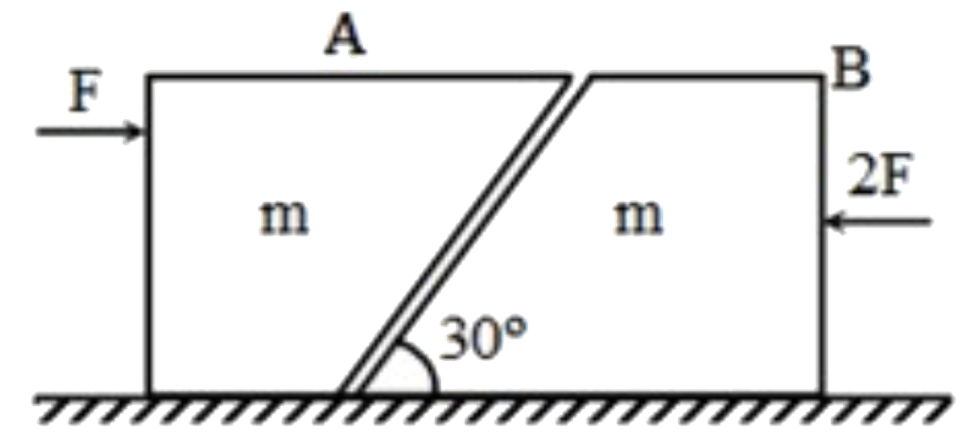Two concave mirrorsof equal radi of curvature R are fixed on a stand facing opposite directions. The whole system has a mass m nd is kept onn a frictionlesss horiztonal table figure

Two blocks A and B, each of mass m, are placed on the two side of the stnd. At t=0, teh separation between A and the mirrors is 2R and also the separation between B and the mirrors is 2R. The block B moves towards the mirror at a speed v. All collisions which take place are erastic. Taking the original position of the mirrors stand system to be x=0 and X -axis along AB, find the position of the image of A and B at t=
a.Rυ, b. 3Rυ c. 5Rυ
The correct Answer is:A, B, C, D
Step by step video, text & image solution for Two concave mirrorsof equal radi of curvature R are fixed on a stand facing opposite directions. The whole system has a mass m nd is kept onn a frictionlesss horiztonal table figure Two blocks A and B, each of mass m, are placed on the two side of the stnd. At t=0, teh separation between A and the mirrors is 2R and also the separation between B and the mirrors is 2R. The block B moves towards the mirror at a speed v. All collisions which take place are erastic. Taking the original position of the mirrors stand system to be x=0 and X -axis along AB, find the position of the image of A and B at t= a. R/(upsilon), b. (3R)/(upsilon) c. (5R)/(upsilon) by Physics experts to help you in doubts & scoring excellent marks in Class 12 exams.
Updated on:21/07/2023Topper's Solved these Questions
Similar Questions
Two blocks A and B each of equal masses m are released from the top of a smooth fixed wedge as shown in the figure. Find the magnitude of the acceleration of the centre of mass of the two blocks.

View SolutionTwo blocks each of mass m are placed on a smooth horizontal surface.They attract each other with a force F=kr where r is the separation between them.Calculate work required to increase the separation between the blocks slowly from a to 2a.
View Solution
Knowledge Check
Four point masses each of mass m are placed on vertices of a regular tetrahedron. Distance between any two masses is r.
AGravitation field at centre at zeroBGravitation potential at centre is −4GmrCGravitation potential energy of system in −6Gm2rDGravitation force on one of the point mass is √6Gm2r2Two blocks each having a mass M are placed as shown in the figure. The accleration of the system is:-
 A0Bgsinθ2CgsinθD2gsinθ
A0Bgsinθ2CgsinθD2gsinθ
A Convex mirror of radius of curvature R is fixed on a standat rest with total mass m which is facing a block of equal mass m as shown in figure and is kept on a frictionless horizontal surfece. The separation between the block and mirror is 2R and block is moving at a speed v toward the mirror. Consider elastic collision between block and stand, find the speed of image after time 3R/v.

View SolutionTwo blocks A and B of equal masses are released on two sides of a fixed wedge C as shown in figure. Find the acceleration of centre of mass of blocks A and B. Neglect friction.

View SolutionA small block of mass m and a concave mirror of radius R fitted with a stand lie on a smooth horizontal table with a separation d between them. The mirror together with its stand has a mass m. The block is pushed at t = 0 towards the mirror so that it starts moving towards the mirror at a constant speed V and collides with it. The collision is perfectly elastic. Find the velocity of the image (a) at a time t<dV, (b) at a time t>dV.
View SolutionTwo blocks 'A' and 'B' each of mass 'm' are placed on a smooth horizontal surface . Two horizontal force F and 2F are applied on the blocks A and B , respectively , as shown in figure . The block A does not slide on block B . The normal reaction acting between the two blocks is

View SolutionAn object of mass m is moving with velocity ữ towards a plane mirror kept on a stand as shown in the figure. The mass of the mirror and stand system is m. A head- on elastic collision takes place between the object and the mirror stand the velocity of image before and after the collision is
View SolutionTwo concave mirrors of equal focal lengths are placed facing each other with their principal axes coinciding. An object O is to be placed at the mid-point between mirrors. What should be the separation between mirrors so that only one image is formed?
View Solution
